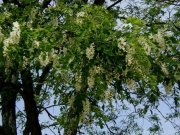Black locust
Description
A small deciduous tree, Robinia pseudoacacia, native to the Appalachian and Ozark Mountains of the United States. The black locust tree produces hard, tough wood used for outdoor construction, fence posts, and mine timbers. The tree is often planted along European streets because it is pretty and tolerates pollution well.
Synonyms and Related Terms
black locust (Robinia pseudoacacia); Gewöhnliche Robinie (Deut.); Falsche Akazie (Deut.); Silberregen (Deut.); robinier (Fr.); robinia (It., Ned., Port.); falsa acacia (Esp., It.); valse acacia (Ned., Port.); Robinia akacjowa (Pol.); false acacia; yellow locust; North American locust
Risks
All parts of tree are considered toxic.
Physical and Chemical Properties
- Medium tree growing to 15-25 m
- Bark=thick, fibrous gray to brown color
- Leaves = alternate pinnate
- Flowers=fragrant white hanging cluster (10 cm long) in late spring.
- Fruit = pale brown flat pod containing kidney shaped beans; ripens in fall.
- Density = 55-65 ppcf
Resources and Citations
- Schoch, W., Heller, I., Schweingruber, F.H., Kienast, F., 2004:Wood anatomy of central European Species: Locust,False Acacia, Robinia pseudoacacia L.
- G.S.Brady, Materials Handbook, McGraw-Hill Book Co., New York, 1971 Comment: p. 462
- F. H. Titmuss, Commercial Timbers of the World, The Technical Press Ltd., London, 1965 Comment: 55-65 ppcf
- Dictionary of Building Preservation, Ward Bucher, ed., John Wiley & Sons, Inc., New York City, 1996
- Virginia Tech Dendrology website at www.fw.vt.edu/dendro/dendrology/main.htm (accessed Oct. 8, 2005)
- Wikipedia: http://en.wikipedia.org/wiki/Black_locust (Accessed Oct. 8, 2005)
- Random House, Webster's Encyclopedic Unabridged Dictionary of the English Language, Grammercy Book, New York, 1997
- The American Heritage Dictionary or Encarta, via Microsoft Bookshelf 98, Microsoft Corp., 1998
Description
A common name for a genus (Robinia) of North American hardwood trees. Locust tree have long paper pods that contain hard seeds. The black locust (Robinia pseudoacacia) is native the the Appalachian mountain region. It produces a heavy dark wood that was formerly used for shipbuilding and is now used for fence posts and outdoor trim. Locust trees are also planted for shade.
| Density | 55-65 ppcf |
|---|
Sources Checked for Data in Record
- F. H. Titmuss, Commercial Timbers of the World, The Technical Press Ltd., London, 1965 Comment: 55-65 ppcf
- Dictionary of Building Preservation, Ward Bucher, ed., John Wiley & Sons, Inc., New York City, 1996
